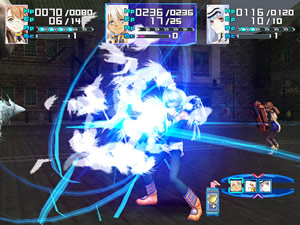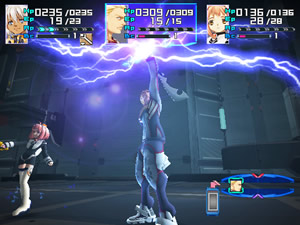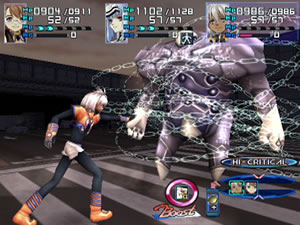Shift into a new gear.
It’s said that the best laid plans of mice and men oft go awry. Now I don’t know what those
mice are planning, but it sure seems like things never go quite the way you intend.
Take Pinocchio – that ungrateful little wooden snot. Gepetto just wanted a son,
and Pinocchio goes out and makes an ass of himself. Literally.
Or how about KOS-MOS, the nigh-invincible battle android? Shion, the Chief
Engineer behind KOS-MOS, has spent the better part of her life “mothering” the
AI programming, attempting to not only grant KOS-MOS the strength to protect,
but the heart to care. But when KOS-MOS is unleashed, she isn’t quite what Shion
expected.
The
original Xenogears wasn’t completely
what the developers at Monolith Soft had in mind, either. Xenogears was
meant as the fifth chapter in a larger epic. Given the chance by Namco to do
their story right, Monolith has started anew with the first episode of Xenosaga.
Xenosaga begins with the destruction of Earth after the discovery of
the mysterious artifact, the Zohar. Four thousand years later, Shion, KOS-MOS,
and a host of other characters are drawn together in the battle against the
Gnosis, an alien species out to purge mankind.
Oddly enough, humans look realistic in the destroyed present, but 4000 years
later, we’ve “evolved” into anime characters with saucer-sized eyes. What a
future to look forward to.
The world of Xenosaga takes ample license from the worlds of sci-fi
and mech-driven stories such as Star Wars, Macross and Evangelion. It then finishes
it off with a large cast of characters, philosophical debates and literary parallels,
creating a unique backdrop for a role-playing game.
The story is told largely through cinematics that take up a great percentage
of the game, sometimes a half-hour at a time. The cinematics and the actual
gameplay are like oil and water. The yet-to-be-reached ideal for any game would
be an emulsion of the two, where the sense of a movie and the sense of a game
are indistinguishable. In Xenosaga, the movies and the game are separate
entities.
Despite this, the cinematics are well-crafted affairs that propel the gameplay
forward. The gaming parts, in turn, push more movies. Overall, the ratio of
video to game feels equivalent to Metal
Gear Solid 2, but because Xenosaga as a whole is longer, the cinematics
feel more drawn out.
The gameplay rides high with an appreciated harder difficulty level than other recent console role-playing games. There are many ways to upgrade and customize your characters, from individual stat manipulation to evolving and developing new skills and ether (magic) moves.
These developed abilities are critical to combat, which focuses on effective
micro-management of limited moves to minimize damage and maximize offense. Characters
begin their turn with a limited number of action points to spend. By choosing
to make only one attack or simply guarding, there will be enough action points
to access stronger moves at the next turn. But playing conservatively also puts
the characters at risk for damage. The strategy is to eliminate each individual
enemy as quickly as possible, thus limiting chances for retaliation.
Each character has both short and long-range attacks that can be comboed.
Some characters can also board battlemechs. These Anti-Gnosis Weapons Systems
(AGWS) have beefed up strength, but are expensive to maintain and are generally
used to complement the more basic battle moves.
When you select a character to heal, an arrow indicator will point to the
recipient. Because the battle viewpoint is often isometric and there are two
rows the characters can occupy, it isn’t always quickly obvious at whom the
arrow is pointing.
To solve this, an immobile green rectangle at the bottom left of the character
data bar shows which character you’re pointing to. I think it would be more
helpful if this green bar moved underneath the character data bar as
a highlight. An ideal interface should transmit information as quickly and effortlessly
as possible, but in Xenosaga it gets muddled.
 Before
Before
a battle commences, the characters have a limited ability to push the odds in
their favor. With precise timing, explosive objects can be vaporized in range
of the visible, non-randomly encountered enemies. This system is great for haters
of random encounters, but it doesn’t have quite the freedom of Breath of
Fire: Dragon Quarter‘s monster avoiding techniques.
The Japanese convention for Playstation games is that the O button is “Yes,”
and X equals “No.” The bulk of U.S. games consistently reverse this trend. Xenosaga
has left the controls in the original Japanese style. I don’t know why, whether
to be true to the original or just plain laziness, but this only poses a problem
if you are playing multiple RPGs at once.
The game has a consistent space-age, brushed-metal gloss, with clever, emoting
character designs (one character seems to be patterned after David Bowie, and
is appropriately name Ziggy) and realistically designed environments (as real
as interior layouts of spaceships can be, I imagine). Sometimes the explosions
in some cinematics look a little too real, like superimposed stock footage over
the game.
No music is played during exploration. Instead the atmospheric hums, such
as the churn of a spacecraft engine and the metallic echoes of footsteps, whisper
through the speakers. During the cutscenes, the music, as performed by the London
Philharmonic, has an appropriately big symphonic feel. The individual voices
and performances fit the characters well.
While Xenosaga doesn’t reinvent the RPG genre, it really captures an
epic scale and carries loads of potential. While I disagree that the future
of RPGs entails such a separation between movie and game elements, the two still
propel one another in the best interests of the story. The gameplay holds it
own, and in all, there’s a lot of promise for what lies ahead.
How this brainchild ultimately turn out still waits to be seen across the
five upcoming installments, but Xenosaga Episode I is an appropriate
bang to start things off. Hopefully, Episode 6 won’t have a village of Jar-Jars.

-
Epic feel
-
Good difficulty
-
Strong battle system
-
Interface disagreements
-
Movie, game, movie, game...










